As the automotive industry accelerates towards electrification, comparisons between all-electric and hybrid models are becoming increasingly relevant. In this article, we delve into a head-to-head comparison of the Mercedes EQB and the VW Tayron, two dynamic SUVs that offer robust performance and an array of technological innovations. While the EQB champions an all-electric powertrain, the Tayron boasts a diverse lineup of engines, including petrol, hybrid, and diesel variants. Let's explore their technical specifications and innovations.
Mercedes EQB vs VW Tayron – Performance, range & efficiency compared
Power and Performance
The Mercedes EQB showcases a fully electric platform with multiple power outputs ranging from 190 to an impressive 292 HP, making it a compelling choice for those leaning towards an electric vehicle. The electric SUV also provides substantial torque, peaking at 520 Nm, which contributes to a swift acceleration from 0 to 100 km/h in just 6.2 seconds for the top variant.
In contrast, the VW Tayron offers a myriad of engine options, producing between 150 to 272 HP with corresponding torque ranging from 250 to 400 Nm. This flexibility allows drivers to choose an engine that suits their performance needs, with the Tayron's most potent version achieving a 0-100 km/h time of just 6.1 seconds. The Tayron's engines also come with configurations for both front-wheel and all-wheel drives, enhancing its versatility across various driving conditions.
Range and Efficiency
In the realm of electric range, the EQB shines with an impressive maximum range of up to 533 km, depending on the variant. The efficient design gives this electric SUV a consumption rate as low as 15.2 kWh/100 km. Its battery capacity varies between 66.5 to 70.5 kWh, providing ample energy for longer journeys without frequent charging.
The VW Tayron, while equipped with conventional and hybrid powertrains, showcases a distinct approach to fuel efficiency. With consumption figures starting from approximately 5.4 L/100 km for its hybrid variant, the Tayron emphasizes a greener driving experience. However, its purely electric range peaks at 126 km, a significant difference compared to the EQB’s capabilities.
Interior Space and Technology
Both vehicles prioritize passenger comfort and cargo space. The Mercedes EQB offers a spacious interior for up to five occupants and a trunk capacity of 495 liters. The design embraces a high-tech feel, bolstered by advanced features such as a large infotainment screen and the latest MBUX system that enables voice recognition and AI-assisted controls.
On the other hand, the VW Tayron excels in practicality with a trunk capacity that reaches up to 885 liters, providing more space for everyday use. Its infotainment system is intuitive and integrates well with modern smartphones, making connectivity seamless for tech-savvy users. Enhanced driver assists and safety features round out the Tayron's offerings in this category.
Driving Dynamics and Innovations
The Mercedes EQB provides a unique driving experience, largely attributed to its electric platform. The low center of gravity and near-silent operation enhances the driving dynamics, giving drivers a relaxed yet invigorating ride. Furthermore, the EQB is equipped with various driving modes, allowing it to adapt to different terrains and preferences.
The VW Tayron, while traditionally powered, incorporates advanced driving aids and adaptations. The adaptive cruise control, lane-keeping assist, and a robust safety suite create a comprehensive driving aide, ensuring driver and passenger safety. The VW also integrates a dual-clutch transmission for a smooth driving experience, further enhancing its road performance.
Conclusion
Ultimately, choosing between the Mercedes EQB and the VW Tayron boils down to individual preferences for powertrains and driving styles. The EQB stands out with its all-electric capabilities, extensive range, and technological advancements, ideal for those committed to sustainability. In contrast, the Tayron offers a versatile range of engine options, practicality, and a focus on hybrid efficiency, making it suitable for a broader audience. Both models set a high standard in the SUV segment, showcasing innovative engineering and design that meet the demands of modern drivers.
Here’s where it gets real: The technical differences in detail
Costs and Efficiency:
When it comes to price and running costs, the biggest differences usually appear. This is often where you see which car fits your budget better in the long run.
VW Tayron has a somewhat advantage in terms of price – it starts at 39600 £, while the Mercedes EQB costs 45900 £. That’s a price difference of around 6257 £.
As for range, the Mercedes EQB performs convincingly better – achieving up to 535 km, about 412 km more than the VW Tayron.
Engine and Performance:
Under the bonnet, it becomes clear which model is tuned for sportiness and which one takes the lead when you hit the accelerator.
When it comes to engine power, the Mercedes EQB has a barely noticeable edge – offering 292 HP compared to 272 HP. That’s roughly 20 HP more horsepower.
In acceleration from 0 to 100 km/h, the VW Tayron is hardly perceptible quicker – completing the sprint in 6.10 s, while the Mercedes EQB takes 6.20 s. That’s about 0.10 s faster.
In terms of top speed, the VW Tayron performs noticeable better – reaching 240 km/h, while the Mercedes EQB tops out at 160 km/h. The difference is around 80 km/h.
There’s also a difference in torque: Mercedes EQB pulls clearly perceptible stronger with 520 Nm compared to 400 Nm. That’s about 120 Nm difference.
Space and Everyday Use:
Whether family car or daily driver – which one offers more room, flexibility and comfort?
Both vehicles offer seating for 5 people.
In curb weight, VW Tayron is distinct lighter – 1682 kg compared to 2105 kg. The difference is around 423 kg.
In terms of boot space, the VW Tayron offers convincingly more room – 885 L compared to 495 L. That’s a difference of about 390 L.
In maximum load capacity, the VW Tayron performs somewhat better – up to 2090 L, which is about 380 L more than the Mercedes EQB.
When it comes to payload, VW Tayron noticeable takes the win – 566 kg compared to 435 kg. That’s a difference of about 131 kg.
Who comes out on top?
Overall, the Mercedes EQB shows itself to be leaves the rival little chance and secures the title of DriveDuel Champion.
It convinces with the more balanced overall package and proves to be the more versatile choice for everyday use.
Costs and Consumption
View detailed analysis
Engine and Performance
View detailed analysis
Dimensions and Body
View detailed analysis
 @ Mercedes-Benz Group Media
@ Mercedes-Benz Group Media
Mercedes EQB
Mercedes EQB
The Mercedes EQB is an electric compact SUV that dresses Mercedes' premium feel in practical clothing, with flexible seating and a serene, composed ride that turns everyday errands into a small luxury. It won't thrill the enthusiast, but for buyers who want a smart, spacious and well-made EV with tasteful tech and real-world usability, the EQB is a sensible, slightly buttoned-up choice that impresses without shouting.
details @ Mercedes-Benz Group Media
@ Mercedes-Benz Group Media
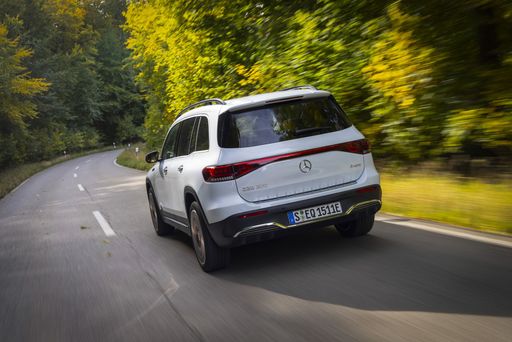 @ Mercedes-Benz Group Media
@ Mercedes-Benz Group Media
 @ Mercedes-Benz Group Media
@ Mercedes-Benz Group Media
 @ Mercedes-Benz Group Media
@ Mercedes-Benz Group Media
 @ Mercedes-Benz Group Media
@ Mercedes-Benz Group Media
VW Tayron
The VW Tayron is Volkswagen's roomy, no-nonsense SUV that pairs clean, familiar styling with a practical cabin built for families and everyday use. It rides comfortably, packs sensible tech and creature comforts, and feels like the sensible sweater of SUVs for buyers who prefer steady value over headline-grabbing drama.
details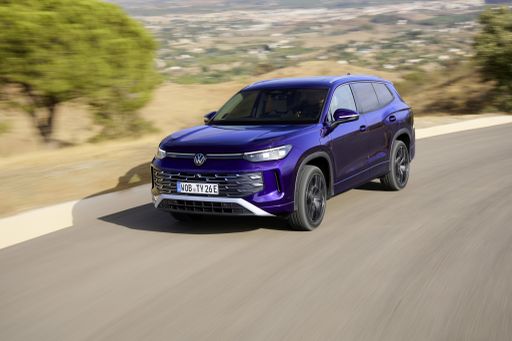 @ Volkswagen AG / VW Media
@ Volkswagen AG / VW Media
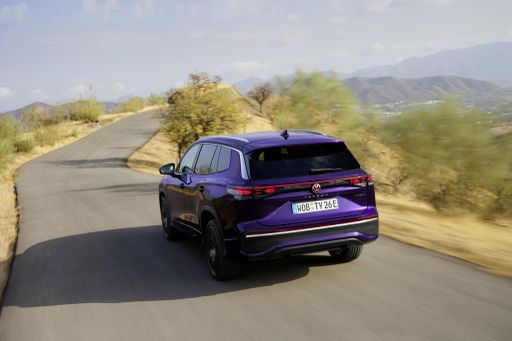 @ Volkswagen AG / VW Media
@ Volkswagen AG / VW Media
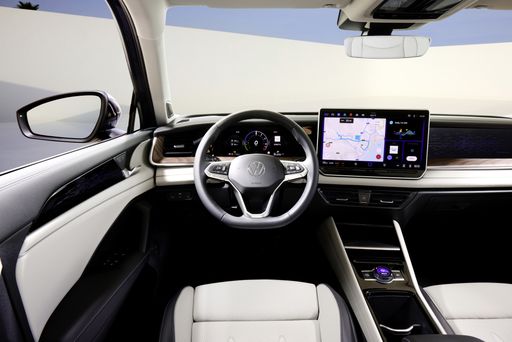 @ Volkswagen AG / VW Media
@ Volkswagen AG / VW Media
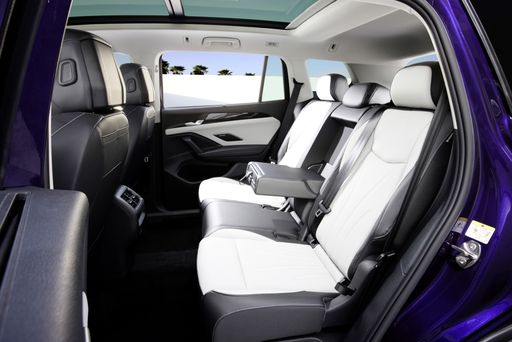 @ Volkswagen AG / VW Media
@ Volkswagen AG / VW Media
 @ Mercedes-Benz Group Media
@ Mercedes-Benz Group Media
|
 @ Volkswagen AG / VW Media
@ Volkswagen AG / VW Media
|
|
|
|
Costs and Consumption |
|
|---|---|
|
Price
45900 - 58900 £
|
Price
39600 - 53300 £
|
|
Consumption L/100km
-
|
Consumption L/100km
1.5 - 8.5 L
|
|
Consumption kWh/100km
15.2 - 17.2 kWh
|
Consumption kWh/100km
-
|
|
Electric Range
468 - 535 km
|
Electric Range
116 - 123 km
|
|
Battery Capacity
70.50 kWh
|
Battery Capacity
19.70 kWh
|
|
co2
0 g/km
|
co2
33 - 192 g/km
|
|
Fuel tank capacity
-
|
Fuel tank capacity
45 - 58 L
|
Dimensions and Body |
|
|---|---|
|
Body Type
SUV
|
Body Type
SUV
|
|
Seats
5
|
Seats
5
|
|
Doors
5
|
Doors
5
|
|
Curb weight
2105 - 2170 kg
|
Curb weight
1682 - 1948 kg
|
|
Trunk capacity
495 L
|
Trunk capacity
705 - 885 L
|
|
Length
4684 mm
|
Length
4792 mm
|
|
Width
1834 mm
|
Width
1853 - 1866 mm
|
|
Height
1654 - 1689 mm
|
Height
1666 - 1668 mm
|
|
Max trunk capacity
1710 L
|
Max trunk capacity
1915 - 2090 L
|
|
Payload
435 kg
|
Payload
489 - 566 kg
|
Engine and Performance |
|
|---|---|
|
Engine Type
Electric
|
Engine Type
Petrol MHEV, Diesel, Petrol, Plugin Hybrid
|
|
Transmission
Automatic
|
Transmission
Automatic
|
|
Transmission Detail
Reduction Gearbox
|
Transmission Detail
Dual-Clutch Automatic
|
|
Drive Type
Front-Wheel Drive, All-Wheel Drive
|
Drive Type
Front-Wheel Drive, All-Wheel Drive
|
|
Power HP
190 - 292 HP
|
Power HP
150 - 272 HP
|
|
Acceleration 0-100km/h
6.2 - 8.9 s
|
Acceleration 0-100km/h
6.1 - 9.7 s
|
|
Max Speed
160 km/h
|
Max Speed
204 - 240 km/h
|
|
Torque
385 - 520 Nm
|
Torque
250 - 400 Nm
|
|
Number of Cylinders
-
|
Number of Cylinders
4
|
|
Power kW
140 - 215 kW
|
Power kW
110 - 200 kW
|
|
Engine capacity
-
|
Engine capacity
1498 - 1984 cm3
|
General |
|
|---|---|
|
Model Year
2024 - 2025
|
Model Year
2025
|
|
CO2 Efficiency Class
A
|
CO2 Efficiency Class
E, F, G, B
|
|
Brand
Mercedes-Benz
|
Brand
VW
|
What drive types are available for the Mercedes EQB?
The Mercedes EQB is available as Front-Wheel Drive or All-Wheel Drive.
The prices and data displayed are estimates based on German list prices and may vary by country. This information is not legally binding.
